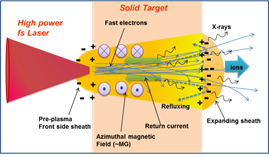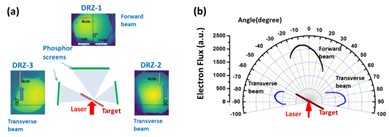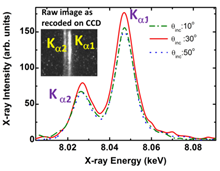|
Fast electron generation and transport in ultrashort high intensity laser matter interaction
With the availability of compact laser system during last few decades, the experimental investigation in ultrashort (tens of fs), ultra-intense (>1018 W/cm2) laser matter interaction have started flourishing. Relativistic fast electrons having energy from 100’s keV to MeV are generated in intense ultrashort laser matter interaction through different laser absorption mechanisms such as resonance absorption, vacuum heating, JxB heating etc. Study of fast electron is a subject of research investigation for basic understanding of laser coupling mechanisms as well as for different potential applications viz. fast ignition approach of laser fusion, MeV proton and ion acceleration, creation of high energy x-ray sources and warm dense matter.
Fast electrons generated in relativistic laser matter interactions propagate through the plasma and cold solid material target producing characteristics line as well as continuum bremsstrahlung x-ray emission. Further, a return current is drawn from the cold background plasma which inhibits the fast electron propagation through matter particularly for resistive materials. Self-generated magnetic fields can modify the fast electron divergence inside material. For thin targets, the energetic electrons escape out of the target and produces high amplitude (~TV/m) electrostatic sheath fields at the target surfaces. This sheath fields prevent majority of electrons from further escaping and therefore the electrons get confined and recirculates within the target known as ‘refluxing’. The whole process is depicted in Fig 1.

Fig. 1: Schematic of fast electron transport through solid density matter.
At RRCAT, extensive experimental investigations have been performed on generation and characterization of fast electrons in intense ultrashort laser foil interaction using 150 TW, 25 fs Ti sapphire laser system. The investigations were carried out by direct measurement of fast electrons as well as indirect measurements of x-rays. Variety of fast electron diagnostics viz. electron detection through phosphor screen-CCD camera combination, magnetic spectrograph and x-ray diagnostics such spherically bent quartz crystal spectrograph and cylindrically bent highly annealed pyrolytic graphite (HAPG) crystal spectrograph were indigenously developed for the experiments.
First, generation of fast electrons was studied in metallic foils using oblique incidence interaction for wide range of parametric variations viz. laser intensity (~0.5 - 7 x1019 W/cm2), laser polarization, incidence angle, pulse duration, focal spot size, preplasma scalelength and target thickness. Figure 2 (a) and (b) show the spatial profile of fast electron beams observed in experiment and their corresponding polar plots. Energetic electron beams were observed along laser propagation direction indicating clear demonstration of JxB heating. Further, electron beams along transverse to propagation direction was also observed for the first time in p polarized interaction. Fast electron temperature was found to be lower than the popular Wilks scaling because of the unique interaction condition occurring at sharp density and energy loss during escaping process at the rear surface. Fast electron generation in presence of larger preplasma density scalelength was investigated using an additional prepulse beam resulting in enhancement of flux and generation of high energy electrons (super-ponderomotive acceleration). Next, strong polarization dependence of JxB accelerated fast electrons was observed.

Fig. 2: (a) Spatial profile of fast electron beams observed in three direction (b) Corresponding polar plots of fast electron beams in the plane of incidence.
A novel technique was used for studying sheath dynamics by creating plasma using metal coating. The electron flux and energy increased for front Al coated mylar due to larger laser energy absorption in longer scalelength preplasma. Further, fast electron flux also increased for rear Al coated mylar but without any change in maximum energy due to delay in formation of rear electrostatic sheath field resulting in larger escaped electron flux.
We have also investigated the intense laser matter interaction in grazing incidence in thick solid target at intensity ~1018 W/cm2. Electrons were observed along target surface direction with divergence of ~30° at smaller scalelength. However, with longer scalelength, the collimated (divergence of ~20±5°) fast electron emission was obtained along the specular direction.
Fast electron generation and transport was studied by measuring high resolution Cu K-a at intensity of ~1019 W/cm2 (Fig. 3). A model of K-a conversion scaling was proposed by incorporating electron temperature scaling and refluxing efficiency. The observed scaling law is in broad agreement with our proposed model on considering heating as dominant mechanism. The study of x-ray conversion with different pulse duration demonstrates the role of reacceleration.

Fig. 3: X-ray emission spectrum at the rear surface of Cu foil for three incidence angle at a laser intensity of ~ 1019 W/cm2 for p polarized laser beam. Inset shows the raw x-ray spectrum.
For more detail please see the publications appearing on the website.
|
















